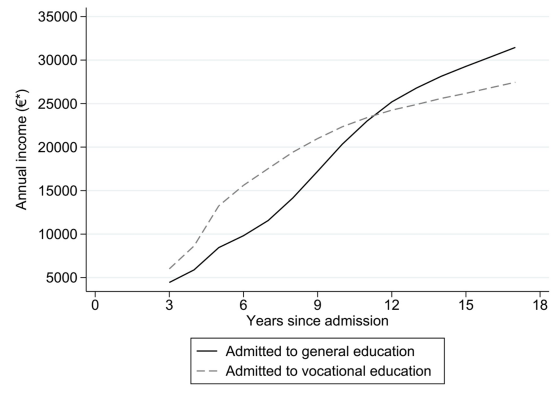Survey results show that receiving vocational education at a young age boosts profits in the long run

On January 30, 2021, Mikko Siriman, a doctoral student at Harvard University, and Hannah Virtanen, a Finnish economic research institute
Access to vocational education can boost income over the long term | VOX, CEPR Policy Portal
https://voxeu.org/article/access-vocational-education-can-boost-income-over-long-term
In some countries, such as Scandinavia, including Finland, children who have completed compulsory education choose to enroll in Japanese high school, ordinary upper secondary school or upper secondary vocational school. For many, it is especially important to understand the potential consequences of the curriculum they are going to, given that this choice will determine the highest educational institution before entering the labor market. However, it is said that each characteristic of both ordinary high school and vocational school has advantages and disadvantages.
Vocational schools facilitate the transition from school graduation to employment and are an alternative to young people who have dropped out of regular high school. It has also been thought that ordinary high schools will brighten the outlook for the labor market later in their careers for students seeking continued education after higher education. On the other hand, there are concerns that the skills acquired at vocational schools may become obsolete due to changes in technology and work.
This way of thinking is consistent with the actual data. The graph below shows the 'employment rate by career path' and 'income data' of students who completed compulsory education in Finland between 1996 and 2000. The vertical axis is the number of months of employment per year, and the horizontal axis is the number of years that have passed since enrollment in the upper secondary education period. You will be overtaken by a regular high school.

In the income graph below, the vertical axis represents the annual income and the horizontal axis represents the number of years that have passed since enrollment. Those who enrolled in a vocational school at the age of 33, 17 years after enrollment in the upper secondary school period. The annual income is 4,000 euros (about 500,000 yen) less than those who enrolled in ordinary high school.

However, as the research so far was susceptible to the size and policy of the cohort surveyed, Siriman et al. Newly examined using the regression discontinuity design , and as a result, those who enrolled in vocational school are obliged. It was shown that the initial annual income will increase compared to those who just got a job after the end of education, and it is expected to increase by 6% at the age of 33. In addition, the graduation rate of vocational school enrollees who later enrolled in higher education institutions is not lower than that of ordinary high school enrollees, and even after graduation, work is replaced by automation and the effects of offshoring. It is unlikely that you will receive it. Furthermore, the employment rate will decrease by nearly 20% in 17 years for those who wish to enroll in a vocational school but do not fulfill it.
These findings suggest that vocational schools are likely to bring valuable skills to those who are unlikely to graduate from high school, with nearly half of students applying to vocational schools in Finland. He concludes with a case study that there may be room to expand vocational school options in other developed countries.
Related Posts:
in Posted by log1p_kr







